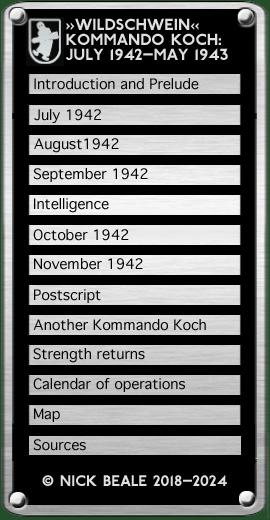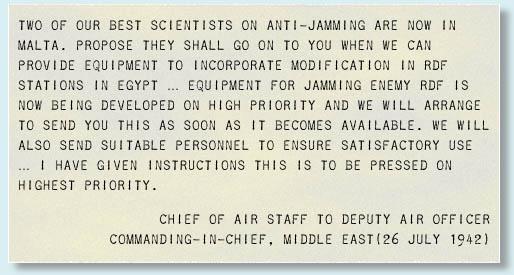|
The use by the enemy of airborne jammers on the … band used by GCI, AI and CHL and on the V.H.F. communication band … must now be considered a probability. Telecommunications Research Establishment (29 June 1942) It was on 2 July that Malta first reported jamming, thought to emanate from points close to lighthouses on the Sicilian coast. Harassing operations carried out from Sicily on night July 3rd claimed to have had greater success than on 2nd. The English apparatus were observed on 14 occasions to switch off for a short time. Further harassing intended night 4/5th. (ULTRA decrypt MK 8234) “Harassing” here might better have been translated as “jamming” since German uses the prefix the prefix »Stör-« (= interference) for both and this interpretation was confirmed in a report from Malta’s Governor to C-in-C Middle East: “Night 4/5, during one raid enemy jammed R.D.F. and G.L. [Gun-Laying radar] Technical reports awaited”. Flight Sergeant Douglas Oxby, a Navigator/Radar Operator with No. 89 Squadron's Malta Detachment recalled: 4–5th July, Ship [F/L Mervyn Shipard RAAF] and I were called out on two night scrambles in [Beaufighter] X7642 [‘G’], but enemy jamming again caused us some problems with the A.I. and resulted in our making no contacts … By this time, considerable difficulty was being experienced with the enemy radio interference affecting the Mk IV A.I. Many patrols were aborted due to the radar being described as u/s. Unknown to us then, the Malta G.C.I. [Ground Controlled Interception] frequencies were being monitored by Axis listeners and their jamming aircraft were instructed when to transmit to cause maximum disruption to our operations. A wireless operator from KGr. 806, Uffz. Herbert Queißer, who was shot down two nights later (in Ju 88 A-4, W.Nr. 1630, M7+MH) related that for about a week, “a German ground installation had been interfering, at first tentatively, with the special equipment in the Beaufighter … and when it is in operation the Ju 88’s can safely approach Malta from any angle”. A British report noted that in the first phase—from 2 July to 19 August—Gun Laying (GL) sets were worst affected, especially those without rising ground to the North of them: There were strong indications that the position of the jammer was changing. While such observations were being made, an RAF TRU station was reporting aircraft circling over the area covered by the GL [gun-laying radar] plots. It therefore seemed highly probable that the jammer was airborne. After the 9th jamming was experienced in daylight as well as by night and at much greater strength: The jammer now appeared on a constant bearing and and it was established that the different jamming frequencies came from the same bearing … In general the [tactical] use of jamming has been haphazard. At night the raiders take no particular care to approach from the direction of the GL jammer. By day, they approach within a few degrees of the jammer bearing.
When the Germans initiated jamming operations against Malta on the night of 2/3 July, the orders from II. Fliegerkorps in Sicily that afternoon had been: “Signals aircraft are deployed from 21.00–01.00 to jam the night fighter radio control”. This information had gone out to the flight safety authorities, to KG 54, KG 77 and to “Noto, via Siracusa”. Noto is a town in Southeastern Sicily, 28 km from Siracusa and around 150 m above sea level. A radio intercept station had been established there in March 1942 by 10./Ln.Rgt. 2 whence “all VHF transmitters on Malta could be heard most distinctly [and] air battles could be followed from take-off to landing”. It would be September before the British learned that it had also become a centre for active radio countermeasures (see below). Orders for 4/5 July announced: Commencement of the intensified battle against the night fighters with attacks on dispersed single-engined [aircraft]. Ta Venezia [Ta’Kali], emphasis on Hurricanes dispersed on the western part of the airfield, since [they are] suspected night fighters (six Hurricanes around Bays 72, 73). This time Noto was to transmit jamming signals from 20.40–23.40 and from 01.00–03.40 (local time), augmented by “signals plane KG 54 (in the air)” from 21.00–23.00 and 01.30–03.30. The Seekriegsleitung diary shows that Germans considered their jamming programme a success: Heavy raid against La Venezia airfield on Malta during the night of the 6/7th, during which enemy night fighters were effectively neutralised by a jamming operation against radar sets. The combination of ground-based and airborne jamming would be employed repeatedly s efforts continued to suppress Malta’s air power. The jamming of Malta's ground radars was sufficiently memorable to be depicted in the 1953 feature film Malta Story: |
||||
continued on next page…
|
||||

TIMELINE |
|
1–27 July |
First Battle of El Alamein. |





